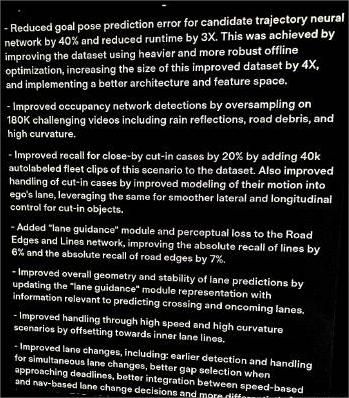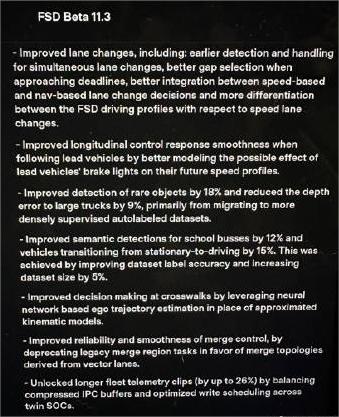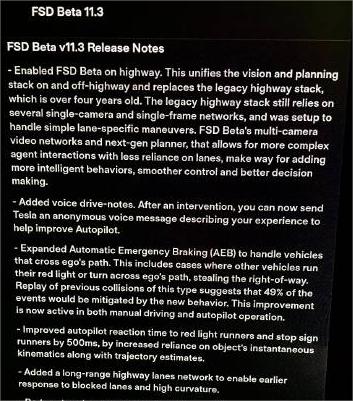Tesla FSD Beta v11.3 Full Release Notes
-
FSD Beta is now enabled on highways. This unifies the visual and planning stacks on the highway and non-highway, replacing the traditional highway stack of over four years. The traditional highway stack still relies on a few single cameras and single frame networks and is set up to handle simple lane-specific operations. FSD Beta’s multi-camera video network and next-generation planner allow for more complex agent interaction, reducing reliance on lanes and paving the road for adding smarter behaviors, smoother controls, and better decision making.
-
Added voice driving notes. You can now send Tesla an anonymous voice message describing your experience to help improve the autopilot.
-
Expanded automatic emergency braking (AEB) to handle vehicles crossing its path. This includes vehicles running red lights or turning through its path, contesting road rights.
-
Replays of previously this type of collision show that 49% of events will be mitigated by new behavior. This improvement is now active in both manual and autonomous driving operations.
-
Improved the autopilot’s reaction time to red light runners and cross traffic by 500 ms by increasing its reliance on instant object kinematics and trajectory estimation.

-
Added a long-distance highway lane network to allow for earlier reaction to lane blockages and high curvature.
-
Reduced the target pose prediction error of the candidate trajectory neural network by 40%, and reduced its run time by 3x. This was achieved by improving the dataset with heavier, more robust offline optimization, increasing the size of the improved dataset by 4x and implementing better architecture and feature space.
-
Improved network detection by oversampling 180k challenging videos, including rain reflections, road debris, and high curvature.
-
Increased the recall rate of near cut-ins by 20% by adding 40,000 auto-labeled fleet segments to the dataset. Additionally, improved the handling of cut-in scenarios by improving modeling of entering self-path motion, which uses the same approach for smoother lateral and longitudinal control of cut-in objects.10. Added “lane guidance module and perception loss” to the road edge and line network, increasing the absolute recall rate of lines by 6% and the absolute recall rate of road edges by 7%.
-
By updating the representation method of the “lane guidance” module and using information related to predicting intersecting and oncoming lanes, the overall geometric shape and stability of lane prediction have been improved.
-
By offsetting the inner lane line, handling of high speed and high curvature situations has been improved.
-
Lane changes have been improved, including earlier detection and handling of simultaneous lane changes, better selection of gaps approaching the deadline, better integration of speed-based and navigation-based lane change decisions, and better differentiation of the relationship between FSD driving profiles and speed lane changes.
-
By better simulating the effect of leading vehicle brake lights on its future speed curve, the smoothness of longitudinal control response when tracking the leading vehicle has been improved.

-
Detection of rare objects has been improved by 18%, and depth error for large trucks has been reduced by 9%, mainly due to the transition to a more densely supervised automatically labeled dataset.
-
Semantic detection of school buses has been improved by 12%, and semantic detection of vehicles transitioning from a stationary to a driving state has been improved by 15%. This is achieved by improving the accuracy of dataset labels and increasing the dataset size by 5%.
-
By using neural network-based self-trajectory estimation instead of approximate kinematic models, decision-making for pedestrian crossings has been improved.
-
By abandoning the traditional merging area task and adopting the merging topology structure obtained from the vector lane, the reliability and smoothness of merging control have been improved.
-
By balancing the compressed IPC buffer and optimized writing scheduling between dual SOCs, longer fleet telemetry segments (up to 26%) have been unlocked.
This article is a translation by ChatGPT of a Chinese report from 42HOW. If you have any questions about it, please email bd@42how.com.
